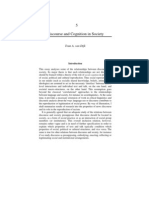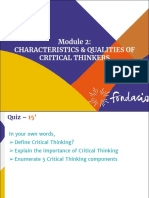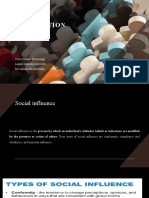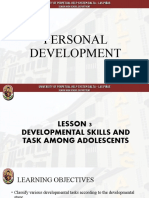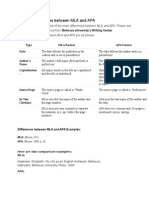0 ratings0% found this document useful (0 votes)
49 viewsIdentity
Identity
Uploaded by
Amatul MusawarIdentity refers to the characteristics that define individuals and groups, including personal experiences, cultural background, social roles, and more. There are multiple dimensions of identity, including personal, social, cultural, psychological, and professional identities. Erikson's theory of identity formation emphasizes exploring different identities during adolescence to develop a cohesive sense of self through committing to values and beliefs.
Copyright:
© All Rights Reserved
Available Formats
Download as PPTX, PDF, TXT or read online from Scribd
Identity
Identity
Uploaded by
Amatul Musawar0 ratings0% found this document useful (0 votes)
49 views13 pagesIdentity refers to the characteristics that define individuals and groups, including personal experiences, cultural background, social roles, and more. There are multiple dimensions of identity, including personal, social, cultural, psychological, and professional identities. Erikson's theory of identity formation emphasizes exploring different identities during adolescence to develop a cohesive sense of self through committing to values and beliefs.
Copyright
© © All Rights Reserved
Available Formats
PPTX, PDF, TXT or read online from Scribd
Share this document
Did you find this document useful?
Is this content inappropriate?
Identity refers to the characteristics that define individuals and groups, including personal experiences, cultural background, social roles, and more. There are multiple dimensions of identity, including personal, social, cultural, psychological, and professional identities. Erikson's theory of identity formation emphasizes exploring different identities during adolescence to develop a cohesive sense of self through committing to values and beliefs.
Copyright:
© All Rights Reserved
Available Formats
Download as PPTX, PDF, TXT or read online from Scribd
Download as pptx, pdf, or txt
0 ratings0% found this document useful (0 votes)
49 views13 pagesIdentity
Identity
Uploaded by
Amatul MusawarIdentity refers to the characteristics that define individuals and groups, including personal experiences, cultural background, social roles, and more. There are multiple dimensions of identity, including personal, social, cultural, psychological, and professional identities. Erikson's theory of identity formation emphasizes exploring different identities during adolescence to develop a cohesive sense of self through committing to values and beliefs.
Copyright:
© All Rights Reserved
Available Formats
Download as PPTX, PDF, TXT or read online from Scribd
Download as pptx, pdf, or txt
You are on page 1of 13
What is Identity
Identity refers to the distinct characteristics, qualities,
beliefs, values, and behaviors that define an individual or a
group of people. It encompasses the various aspects that
shape a person's sense of self and how they perceive
themselves in relation to others and the world around them.
Identity can be shaped by a multitude of factors, including
but not limited to personal experiences, cultural
background, social interactions, and individual traits.
Dimensions of Identity
Personal Identity: This dimension refers to
the unique characteristics, traits, and
experiences that make an individual distinct
from others. It encompasses elements such as
personality traits, personal history, talents,
skills, and individual preferences.
Social Identity: Social identity relates to the
groups or communities to which an individual
belongs and the social roles they adopt within
those groups. It includes aspects such as
nationality, ethnicity, gender, religion,
socioeconomic status, and sexual orientation.
Dimensions of
Identity
Cultural Identity: Cultural identity refers to the
shared beliefs, customs, traditions, and values
that are transmitted within a particular culture or
subculture. It encompasses factors such as
language, food, art, music, rituals, and cultural
practices.
Psychological Identity: Psychological identity
encompasses an individual's self-perception,
thoughts, emotions, and self-esteem. It includes
aspects such as self-image, self-worth, self-
concept, and self-efficacy
Professional Identity: Professional identity
relates to the roles, skills, and expertise that
individuals develop within their chosen
professions or occupations. It encompasses the
knowledge, qualifications, and experiences that
contribute to a person's professional identity.
Erikson views
Erik Erikson's views on identity are primarily
outlined in his fifth stage of psychosocial
development, known as "Identity vs. Role
Confusion." This stage occurs during adolescence,
typically between the ages of 12 and 18
According to Erikson, identity formation involves
exploring and reconciling various aspects of
oneself, including values, beliefs, goals, interests,
and social roles. Adolescents engage in a process
of self-examination, questioning who they are and
what they want to become. They may experiment
with different identities and roles as they strive to
establish their own sense of identity.
Erikson views
Erikson emphasized that a positive
resolution of the identity crisis leads to the
development of a strong and integrated
identity. This involves the ability to
understand and articulate one's values,
beliefs, and life goals, as well as a sense of
continuity and coherence across different
contexts and roles. A well-formed identity
provides a foundation for making decisions,
navigating relationships, and pursuing a
fulfilling life.
Erikson views
• Erikson believed that during this stage,
adolescents rely on a variety of sources to
shape their identities. These include
personal experiences, relationships with
peers, interactions with family and
authority figures, societal expectations,
cultural influences, and exploration of
different social roles. Successful resolution
of the identity crisis involves integrating
these various influences into a cohesive
and authentic sense of self
Psychosocial
Moratorium
It refers to a period during adolescence when
individuals are granted a temporary suspension
of adult responsibilities and expectations period
of temporary freedom and exploration in order
to explore different roles, values, and identities.
According to Erikson, the psychosocial moratorium is
a crucial stage in the process of identity formation. It
provides adolescents with a space and opportunity to
experiment, try out different roles, and engage in self
exploration without the full consequences and
commitments of adulthood. During this period,
individuals can explore various possibilities, question
societal norms, and actively search for a sense of
identity
Crisis (Exploration)
• Crisis refers to a period of active questioning,
exploration, and examination of different values,
beliefs, interests, and life goals. It involves a sense of
uncertainty, confusion, and questions about one's
identity. During a crisis, individuals actively seek out
information, engage in self-reflection, and explore
various possibilities to gain a better understanding of
themselves and their identity.
Commitment
• Commitment refers to the psychological investment
individuals make in their chosen values, beliefs,
interests, and life goals. It involves making conscious
decisions and choices based on personal exploration
and self-reflection. Commitment signifies a sense of
personal investment, dedication, and alignment with a
particular identity or set of identities.
Identity Statuses
• Identity Diffusion: Individuals in this status have not
experienced a crisis or made a commitment regarding
their identity. They may be apathetic, avoidant, or
indifferent to exploring and making decisions about
their values, beliefs, and life goals. They lack a clear
sense of direction or commitment and may exhibit a
sense of confusion or uncertainty about their identity.
Identity Statuses
• Identity Foreclosure: Individuals in this
status have made a commitment to an
identity without experiencing a crisis or
exploration. They have adopted values,
beliefs, or life goals based on external
influences, such as parental or societal
expectations, without critically examining
or exploring alternatives. They may lack a
genuine understanding of their own
preferences and may be resistant to
considering other possibilities
Identity
Moratorium
• Individuals in this status are
actively experiencing a crisis or
exploration of different identities
without having made a firm
commitment. They are engaged in
an ongoing process of questioning
and seeking, exploring various
options and possibilities. They
may be open to new experiences,
seeking information, and
considering different perspectives.
This status is characterized by a
sense of active exploration and
questioning.
Identity
Achievement
• Individuals in this status have resolved
their identity crisis by actively exploring
various options and commitments,
ultimately making a clear and committed
identity choice. They have gone through a
process of exploration, critically examining
different possibilities, and have arrived at a
sense of identity that is consistent with
their values, beliefs, and life goals. They
have made conscious commitments and
have a strong sense of self
You might also like
- MarksDocument31 pagesMarksCatalin BanuNo ratings yet
- Body Image QuestionnaireDocument9 pagesBody Image QuestionnaireAmatul Musawar0% (1)
- Sociological Imagination by IsaksenDocument3 pagesSociological Imagination by IsaksenJhoan JaneNo ratings yet
- EthnocentrismDocument10 pagesEthnocentrismNikita SangalNo ratings yet
- Individual Assignment Resume SociolinguisticsDocument15 pagesIndividual Assignment Resume SociolinguisticsUtami ZulisNo ratings yet
- Rite of Passage - NotesDocument5 pagesRite of Passage - NotesCade SNo ratings yet
- ISO 8504-2-02 (Surface Preparation Methods) PDFDocument19 pagesISO 8504-2-02 (Surface Preparation Methods) PDFSilvia Alejandra Caicedo Castellanos100% (2)
- En 13018Document10 pagesEn 13018Hüseyin HızlıNo ratings yet
- PersonalityDocument26 pagesPersonalityRachit GoyalNo ratings yet
- Developmental Stages and TasksDocument4 pagesDevelopmental Stages and TasksRafaelNo ratings yet
- Cultural CompetenceDocument2 pagesCultural CompetenceSUMAYYAH MANALAO100% (1)
- Psychoanalysis: Reporters: Frenz M. Espelico Wilbert SumalinogDocument41 pagesPsychoanalysis: Reporters: Frenz M. Espelico Wilbert SumalinogMissy KabristanteNo ratings yet
- Registers of LanguageDocument1 pageRegisters of LanguageClariz Angelika Escocio100% (1)
- SOCIO FixxsDocument14 pagesSOCIO Fixxshanifatul husniNo ratings yet
- The Four P's of PresentationsDocument10 pagesThe Four P's of PresentationsFarhad TabanNo ratings yet
- Verbal and Non Verbal CommunicationDocument4 pagesVerbal and Non Verbal Communicationskz kingdomNo ratings yet
- Communication Is A Process of Transmitting Information From Origin Recipients Where The Information Is Required To Be UnderstoodDocument10 pagesCommunication Is A Process of Transmitting Information From Origin Recipients Where The Information Is Required To Be Understoodal_najmi83No ratings yet
- Types & Methods of CommunicationDocument6 pagesTypes & Methods of CommunicationNicoleNo ratings yet
- Personality: Freud Psychoanalytic Theory: Defense MechanismsDocument10 pagesPersonality: Freud Psychoanalytic Theory: Defense MechanismsAadil JuttNo ratings yet
- Freud's Stages of Psychosexual Development: Id LibidoDocument37 pagesFreud's Stages of Psychosexual Development: Id LibidoPRE-GAMERS INC.No ratings yet
- Difference Between Structuralism and Post-StructuralismDocument14 pagesDifference Between Structuralism and Post-StructuralismMagelyn FornesteNo ratings yet
- DEVIANT BEHAVIOR - SocpsychDocument16 pagesDEVIANT BEHAVIOR - SocpsychChristine PeñamanteNo ratings yet
- Deconstruction: Jacques DerridaDocument16 pagesDeconstruction: Jacques DerridaZinya AyazNo ratings yet
- The Marxist Theory On Mass MediaDocument11 pagesThe Marxist Theory On Mass MediaAvinShetty100% (1)
- What Is Linguistic Relativity-EllenDocument3 pagesWhat Is Linguistic Relativity-EllenWan Nurhidayati Wan JohariNo ratings yet
- The Pillars of The SelfDocument17 pagesThe Pillars of The SelfJona Addatu100% (1)
- Schools of ThoughtDocument6 pagesSchools of ThoughtDabe Zine100% (1)
- Module 5 - The Social SelfDocument24 pagesModule 5 - The Social SelfGirlie CruzNo ratings yet
- Culture Language and CommunicationDocument4 pagesCulture Language and CommunicationRayina AilsaNo ratings yet
- 06 Chapter 1 PDFDocument37 pages06 Chapter 1 PDFShreya HazraNo ratings yet
- 345 - Speaking and ListeningDocument3 pages345 - Speaking and ListeningSuzanne TraversNo ratings yet
- IGNOU Block 1 Unit 2 Healthcare PlanningDocument21 pagesIGNOU Block 1 Unit 2 Healthcare Planningerice.researchNo ratings yet
- Resolving Social Dilemmas-1Document5 pagesResolving Social Dilemmas-1Amatul Musawar100% (1)
- Discourse and Cognition in SocietyDocument21 pagesDiscourse and Cognition in SocietyDesislava ZarevaNo ratings yet
- Creative Writing 1Document48 pagesCreative Writing 1Tesfu HettoNo ratings yet
- Barrier To CommunicationDocument41 pagesBarrier To CommunicationpadmaNo ratings yet
- Person Centered TherapyDocument4 pagesPerson Centered Therapysusanwhitten100% (2)
- Foucault DiscourseDocument2 pagesFoucault DiscourseViciAlfananiNo ratings yet
- Travels Explores The Idea of Utopia-An Imaginary Model of The IdealDocument3 pagesTravels Explores The Idea of Utopia-An Imaginary Model of The IdealTanveer AkramNo ratings yet
- Dimensions of Self-Management CompetenciesDocument12 pagesDimensions of Self-Management Competenciesvairampearl0No ratings yet
- 5 Types of CommunicationDocument5 pages5 Types of CommunicationFiziksaNo ratings yet
- DIFFUSIONISMDocument14 pagesDIFFUSIONISMrieann leonNo ratings yet
- Characteristics of A Critical ThinkerDocument25 pagesCharacteristics of A Critical ThinkerLuận DominicNo ratings yet
- 4.1 Social InteractionDocument20 pages4.1 Social Interactionsabahat saeed100% (1)
- 2 Forms of CommunicationDocument12 pages2 Forms of CommunicationVinodh ManiNo ratings yet
- What Can You Teach A Dog, A Cat, and Rat?Document38 pagesWhat Can You Teach A Dog, A Cat, and Rat?Sohaib AnjumNo ratings yet
- The Humanistic ApproachDocument7 pagesThe Humanistic ApproachVenessa JonesNo ratings yet
- 8606 - Citizenship Education and Community EngagementDocument25 pages8606 - Citizenship Education and Community EngagementEvelinaNo ratings yet
- Ethnomethodology: The Organization of Practical Actions and Practical ReasoningDocument2 pagesEthnomethodology: The Organization of Practical Actions and Practical ReasoningUme LailaNo ratings yet
- PPF - Self IdentityDocument3 pagesPPF - Self IdentityAayush AnejaNo ratings yet
- Barriers To CommunicationDocument3 pagesBarriers To Communicationapi-373872188% (8)
- Io Psych RevDocument10 pagesIo Psych Revkdh yjmNo ratings yet
- B - Foundations of SociologyDocument34 pagesB - Foundations of SociologyamdeguzmanNo ratings yet
- Determinants of IntelligenceDocument10 pagesDeterminants of IntelligenceAditi VermaNo ratings yet
- Cultural Competency, Assignment 2, Group 7Document5 pagesCultural Competency, Assignment 2, Group 7Harneet SinghNo ratings yet
- Hofstede's Cultural Dimensions TheoryDocument2 pagesHofstede's Cultural Dimensions TheoryNguyễn TháiNo ratings yet
- Precursors of StructuralismDocument12 pagesPrecursors of Structuralismsara batool syedNo ratings yet
- Real Self VS Ideal SelfDocument3 pagesReal Self VS Ideal SelfCharma CharlesNo ratings yet
- PsycholinguisticsDocument8 pagesPsycholinguisticsNoor UlainNo ratings yet
- Developmental PsychologyDocument12 pagesDevelopmental Psychologyminahilnoor771No ratings yet
- Socialization and Development Identity and Social RelationsDocument9 pagesSocialization and Development Identity and Social RelationsCyrel QuiawanNo ratings yet
- Positive and Negative Roles of IdentityDocument16 pagesPositive and Negative Roles of IdentityBhuvneshwari Rathore100% (1)
- Script GeuselfDocument3 pagesScript GeuselfPriyanka Semitara RogandoNo ratings yet
- Concept and Development of IdentityDocument14 pagesConcept and Development of Identitymuhammadnasif32No ratings yet
- Advance PresentationDocument33 pagesAdvance PresentationAmatul MusawarNo ratings yet
- Final PresentationDocument25 pagesFinal PresentationAmatul MusawarNo ratings yet
- Resolving Social Dilemmas-1Document5 pagesResolving Social Dilemmas-1Amatul Musawar100% (1)
- Introduction To Developmental Psychology: Prepared by Ms. Sana AslamDocument22 pagesIntroduction To Developmental Psychology: Prepared by Ms. Sana AslamAmatul MusawarNo ratings yet
- DP Assign 4Document19 pagesDP Assign 4Amatul MusawarNo ratings yet
- BiodataDocument9 pagesBiodataAmatul MusawarNo ratings yet
- PPTHERAPYDocument29 pagesPPTHERAPYAmatul MusawarNo ratings yet
- Sample ThesisDocument50 pagesSample ThesisAmatul MusawarNo ratings yet
- Prenatal Development and Birth: Prepared by Ms. Sana AslamDocument12 pagesPrenatal Development and Birth: Prepared by Ms. Sana AslamAmatul MusawarNo ratings yet
- Positive Youth Development Perspective The InterplDocument5 pagesPositive Youth Development Perspective The InterplAmatul MusawarNo ratings yet
- Tittle PageDocument1 pageTittle PageAmatul MusawarNo ratings yet
- Draft ResearchDocument2 pagesDraft ResearchAmatul MusawarNo ratings yet
- FormatDocument5 pagesFormatAmatul MusawarNo ratings yet
- 2 - Behavior & AttitudesDocument15 pages2 - Behavior & AttitudesAmatul MusawarNo ratings yet
- Food and Nutrition UMT Mid TermDocument11 pagesFood and Nutrition UMT Mid TermAmatul MusawarNo ratings yet
- Personality Assessment BDocument57 pagesPersonality Assessment BAmatul MusawarNo ratings yet
- Article Refrences..Document13 pagesArticle Refrences..Amatul MusawarNo ratings yet
- A Dictionary of Units Part 1Document33 pagesA Dictionary of Units Part 1kapil100% (1)
- BS Iso 412-2003Document16 pagesBS Iso 412-2003Michael Leptman D'veckNo ratings yet
- Zadatak 1a Vitlo SkidDocument2,018 pagesZadatak 1a Vitlo SkidAnonymous mKdAfWifNo ratings yet
- Emotional IntelligenceDocument4 pagesEmotional IntelligenceSteve MwenyeNo ratings yet
- Discourse Analysis FINALDocument37 pagesDiscourse Analysis FINALJuan Pablo RobledoNo ratings yet
- 11 Comparing People, Places and ThingsDocument5 pages11 Comparing People, Places and ThingsBernardo Eulogio Bobadilla RodriguezNo ratings yet
- Paper SizesDocument11 pagesPaper Sizessivaprasad589No ratings yet
- All New Keys DictionaryDocument7 pagesAll New Keys DictionaryvishntNo ratings yet
- Theories of Sense and ReferencesDocument3 pagesTheories of Sense and ReferencesawtshfhdNo ratings yet
- Daftar PustakaDocument11 pagesDaftar PustakaOlympic CollegeNo ratings yet
- Lesson 3 Developmental Skills and Tasks Among AdolescentsDocument40 pagesLesson 3 Developmental Skills and Tasks Among AdolescentsAshanti VillanuevaNo ratings yet
- THC 3106 Module 4 Emotional Attributes of PersonalityDocument44 pagesTHC 3106 Module 4 Emotional Attributes of PersonalityKim JosephNo ratings yet
- 6766-Article Text-32862-1-10-20221231Document6 pages6766-Article Text-32862-1-10-20221231hey bibleNo ratings yet
- According To MaslowDocument4 pagesAccording To Maslowfaithparagoso9No ratings yet
- Uts ReportDocument6 pagesUts ReportCamille LatidoNo ratings yet
- An Introduction To Shadow Work How To Accept Every Aspect of Yourself. Learn The Immensely Powerful Technique For Empowering... (Glenn Smith (Smith, Glenn) )Document28 pagesAn Introduction To Shadow Work How To Accept Every Aspect of Yourself. Learn The Immensely Powerful Technique For Empowering... (Glenn Smith (Smith, Glenn) )takudzwarioga100% (2)
- Psychology1Document26 pagesPsychology1Arriana JutajeroNo ratings yet
- 2014 MP NtseDocument37 pages2014 MP NtseXxyyzzNo ratings yet
- Spelling Exercise: Spell: Write Down and Say AloudDocument2 pagesSpelling Exercise: Spell: Write Down and Say AloudVendula MališováNo ratings yet
- UTS PPT of Group 4Document41 pagesUTS PPT of Group 4Jhocel100% (1)
- Psychological Perspective of The SelfDocument7 pagesPsychological Perspective of The Selfkhovid naintineNo ratings yet
- Old - 05. EPC-4 - Understanding The Self Concept - TPDocument6 pagesOld - 05. EPC-4 - Understanding The Self Concept - TPVijay Srivastava100% (1)
- Adjectives QuizDocument2 pagesAdjectives QuizManay MhelNo ratings yet
- Carl Roger's TheoryDocument26 pagesCarl Roger's TheorySamit RajanNo ratings yet
- General Differences Between MLA and APADocument13 pagesGeneral Differences Between MLA and APAKyna Rae Sta Ana100% (1)
- Harvard Referencing GuideDocument14 pagesHarvard Referencing GuideDaren MansfieldNo ratings yet
- Note Making 2Document3 pagesNote Making 2Shubham NagpalNo ratings yet

































